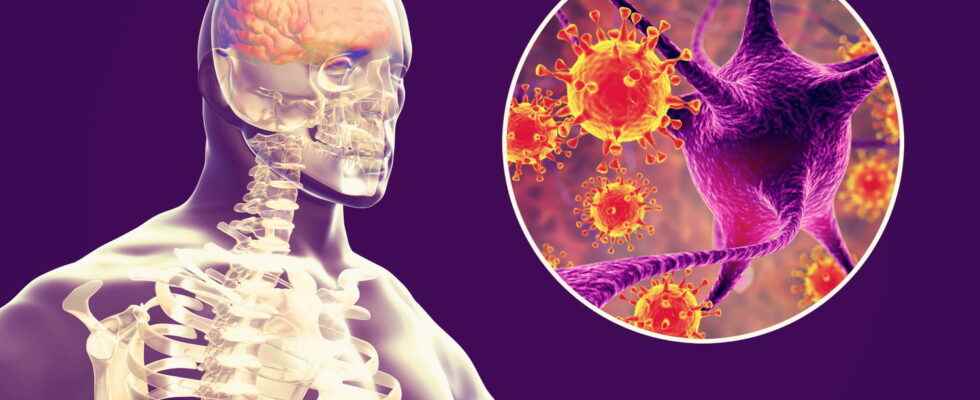Meningoencephalitis is a simultaneous inflammation of the brain and the meninges. It is most often of infectious origin. The point with Dr Virginie-Eve Lvovschi, emergency physician.
Definition: what is meningoencephalitis?
Meningitis is a inflammation of the meninges (the membrane surrounding the brain and spinal cord), it is most often of infectious origin. Often people have headache, nausea, intolerance to light, stiff neck at the exam. The fever is not constant. “These meningitis can be associated with signs of encephalitislinked to cerebral inflammation by contiguity, giving neurological signs of cerebral sufferingspecifies Dr. Virginie-Eve Lvovschi, emergency physician. In addition to the signs of meningitis, one can observe a motor deficit (facial paralysis, hemiplegia), behavioral problemsof the disorientation or abnormal movements such as tremors. We then speak of meningoencephalitis. Most often, the cause of this inflammation is a blood-borne infection by a bacterium or a circulating virus which contaminates the cerebrospinal fluid which bathes the meninges and all the neurological structures of the central nervous system (brain and spinal cord). “Rarely it is secondary to a “proximity” infection (ENT cavities) or to a head trauma.
What are the symptoms of meningoencephalitis?
“In these cases of meningoencephalitis, certain symptoms are almost constant and precocious, such as :
- Strong headaches
- Nausea, Vomiting
Other variables, like:
- Fever.
- Stiffness of the neck.
- Consciousness disorders of variable degree (from simple drowsiness to deep coma)
- Confusional syndrome and behavioral disorders;
- Focusing signs : motor deficit (mono or hemiplegia), paralysis of one or more cranial nerves, aphasia, abnormal movements (tremor, etc.);
- Focal epileptic seizures (without or with impaired consciousness) and generalized;
- Neurovegetative disorders : Irregular pulse, blood pressure and temperature, suggestive of brain stem pain
What is herpetic meningoencephalitis?
Herpetic meningoencephalitis is a infection due to herpes simplex virus (HVS-1 in 95% of cases)the common manifestations of which are oral (HSV-1) or genital (HSV-1 and HSV-2) ulcerations and which in some patients can be expressed by cerebral and meningeal inflammation. “In the case of HSV1, the usual signs of meningitis are weakly marked, but are often accompanied frank encephalitis : a motor deficit (facial paralysis, hemiplegia), aphasia, behavioral disorders, disorientation, abnormal movements such as tremors, up to coma in the most serious forms“, specifies the emergency doctor.
For herpetic meningoencephalitis, treatment with intravenous antivirals is prescribed.
What is primary amoebic meningoencephalitis?
“Primary amoebic meningoencephalitis is a rare meningeal and brain infection and usually fatal due to Naegleria fowleri, a type of free-living amoeba. Amoebas can enter the brain through the nose when people swim in contaminated hot fresh water“, details the specialist.
What is lightning meningoencephalitis?
Lightning meningoencephalitis is a type of bacterial meningoencephalitis. “It is severe while viral meningoencephalitis is often mild, with the exception of herpes zoster type viruses, emphasizes Dr. Lvovschi. The most formidable bacteria are the pneumococcus, meningococcus and Listeria Monocytogenes (responsible for listeriosis in pregnant women in particular)“. Certain signs evoking bacterial meningitis should alert. Sudden onset of an alteration in general condition with fever and chills. “Lightning meningitis is a severe meningitis, the degree of brain damage varies according to the responsible germs. In the case of meningococcus, it is rather accompanied by signs of general shock, such as purpura fulminans hypotension and may be responsible for coma“. The presence of these signs requires a urgent medical consultation.
What causes meningoencephalitis?
Most often, the cause of this inflammation is a acute infection carried by a bacterium or a virus circulating in the cerebrospinal fluid. “Viruses are most frequently responsible, such as enterovirusthe viruses responsible for mumps, measles, influenza and the viruses of the Herpes-Zona groupexplains the doctor. When the disease is bacterial, pneumococcus, meningococcus, Haemophilus influenzae are the most frequently incriminated”. The causes are not the same depending on the age and the vaccination status of the people. “VSIn pregnant women, or people with chronic diseases, the causes are also differents”. Finally, meningoencephalitis is sometimes observed chronic, as in Lyme disease.
What complications and sequelae of meningoencephalitis?
“If left untreated, it can be fatal (20% of cases), especially if it is of bacterial or herpetic origin or cause serious brain damage that leads to sequelae, sometimes irreversible, such as permanent disability, memory impairment and slowed brain function“, answers the specialist.
What treatment to treat meningoencephalitis?
“When the diagnosis of meningoencephalitis is confirmed, treatment should be started as soon as possible and hospitalization is most often required“, points out our interlocutor. For most viral meningitis, the therapies are not specific to this disease and are mainly symptomatic. “Only herpetic meningoencephalitis requires intravenous antiviral therapy“. “For bacterial meningitis, we are going to set up a high-dose intravenous antibiotic therapy. It will be adapted secondarily according to the germ found during the paraclinical examinations. A first intramuscular dose as soon as the disease is strongly suspected is sometimes offered early, including in the general practice.
Thanks to Dr Virginie-Eve Lvovschi, emergency doctor at the Hospices Civils de Lyon.
